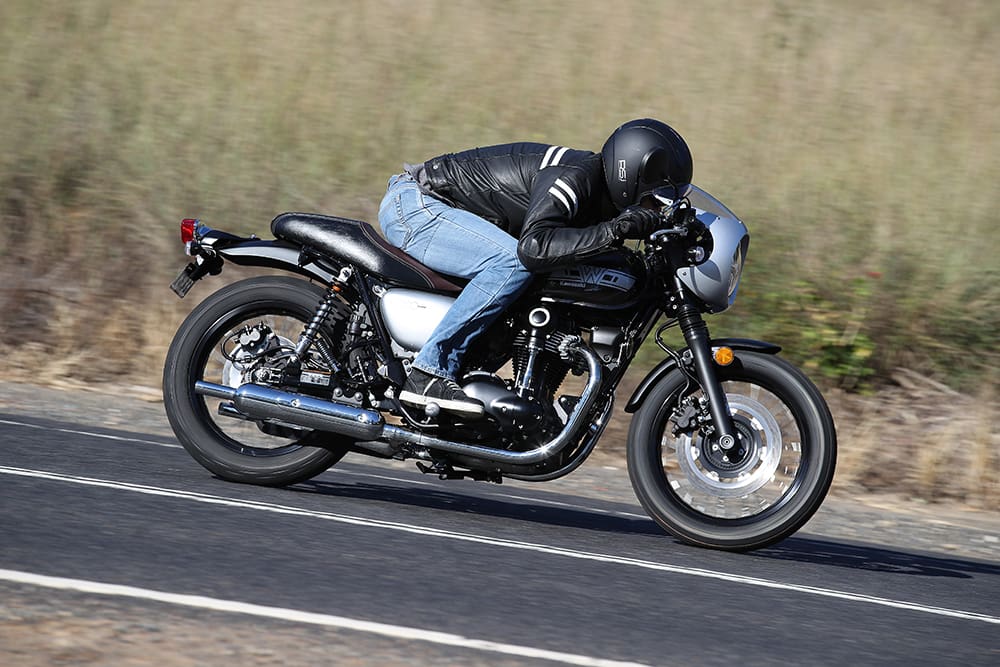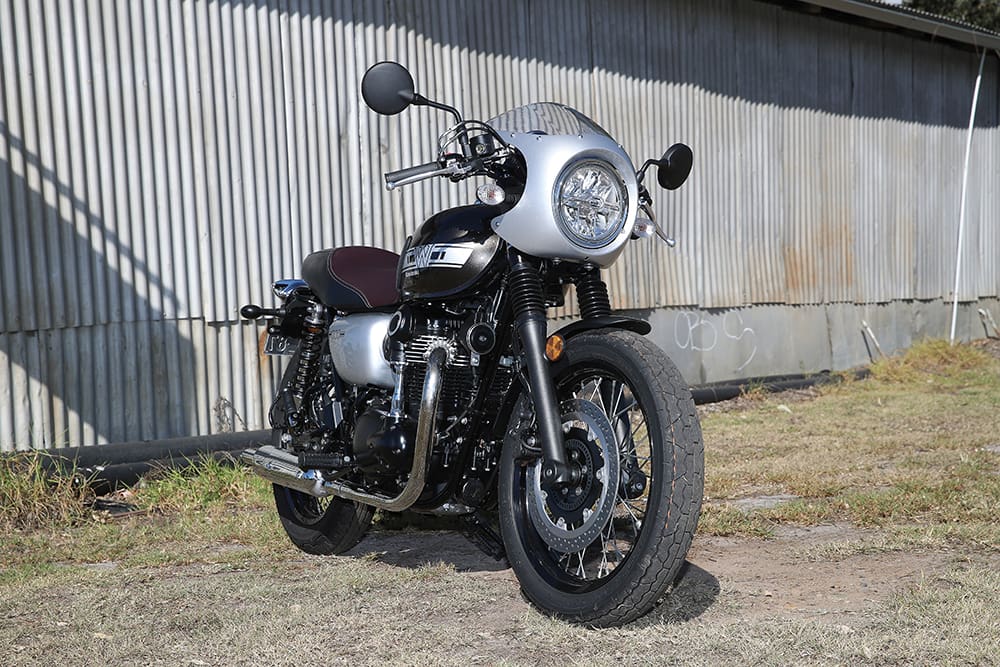The W800 Café couldn’t look or sound more sixties – thankfully it rides a whole lot better
Start. Giggle. Turn. Giggle. Brake, gear change, accelerate. Giggle. I was having an amusing old time on Kawasaki’s latest café-set pleaser, the W800 Café, but I was laughing with it, not at it.
One look at its name and the bike itself and you know it’s the latest in a long line of modern classics manufacturers are dealing out in an effort to gain the hard-earned from our aging motorcycling population. The W800 was always that way, owing its existence as it does to the 1966 W1, but the new bits adorning the Café version are aimed at modernising the parallel-twin engine – Kawasaki’s marketing team has even named the engine the Modern Vertical Twin – allowing it to live on.
LED headlights, ABS-equipped brakes, a new double cradle frame and a 41mm right-way-up fork are the modern side to the equation, as well as an assist and slipper clutch and O2 sensor – but there’s lots of retro, too. The M-shaped ’bars, for instance, modern clocks that resemble the old versions yet feature a small LCD screen not thought of in the 1960s, and that grey/silver paint job. Importantly, there’s also a set of shmick spoked wheels – all up, Kawasaki has done an excellent job of the classic aspect of the name. It looks just like a modern classic should, in my mind, and it feels like one, too, when you swing aboard.
The ride position is fun, partly because it’s unique in the world today and partly because it works so well. Once you stop giggling at the exhaust note squirting out of the pea-shooter exhaust, anyway.
Kawasaki calling the engine a Modern Vertical Twin pricked my ears up, because if it felt the need to call it that, then perhaps it, well, isn’t too modern at all. It certainly doesn’t sound modern – I love the air-cooled note, it sounds exactly like the bike looks. I didn’t want a smooth and tidy modern note out of that exhaust, and I didn’t get it. It’s a classic note alright, and it’s that way on purpose – the W800’s 360° crankshaft configuration makes it that way. And it works.
With EFI, though, the bike starts like a modern one and the throttle feel is up-to-date, too, as long as you aren’t expecting too much from a 773cc air-cooled parallel twin. Kawasaki claims 35kW (48hp) at 6000rpm and 62.9Nm@4800rpm, so it’s not going to set the quarter-mile drag world alight. But it’s not meant to.
Classic bikes, even modern ones, are ‘classic’ because they offer a feel to them, and it’s hard to manufacture that. Kawasaki has managed to do that, though, even if some vibrations are part of the character of the bike. And when I say some, I found the vibrations at freeway speeds intrusive for long periods of time. That new frame couldn’t isolate the vertical-twin vibes quite enough.
Rolling up and down the tacho, though, and the bike is happy to nose its way through classic backroads. Without large power to play with, the enjoyment is connecting a series of corners together and you can only do that with a sweet handling bike. The bike’s ergonomics play a big part in this, and it’s uncanny how good I felt cornering this bike while hanging onto those oddly-shaped bars.
Their shape offers plenty of feel from the front 18-inch wheel and encourages a classic riding position through corners and everywhere else. Hanging to the inside of the bike for cornering clearance (and just plain style) is one of the fun aspects of riding a modern classic and one I
really enjoyed – if it’s going to look modern, it needs to feel it, too. The W800 Cafe does. You
will be smiling in your riding goggles as your brain goes all ’60s.

While there is a lot of feel, the bike isn’t harsh. It’s not light, at 223kg claimed, and that weight helps the bike sit on the road nicely, working well with the new suspension. The boingers aren’t the most sophisticated out there, however they are compliant enough and handle above-design-brief riding in a predictable way. Again, if you’re an elbow-dragging rider, head for a ZX-10R instead. The W800 Café will light up your inner sportsbike rider, but in a classic way. It’s fun and it’s engaging.
Slicing through a rock-walled rider’s road, that giggle reflex was in full flight. The pea shooter exhaust sounds like an old bike movie and as I crouched over the tank, head as far under the bubble as I could get it (not far), the grin was wide. Rolling off the throttle for a corner, I revelled in the burbles from out the back, even if the single front brake wasn’t actually banging my eyeballs off the visor – it’s predictable enough though, and better than any 1960s bike’s brakes (or more consistent, anyway).
As long as a bike steers well, it will feel like it handles well and the W800’s new frame does let you pick your line between the potholes beautifully, even if maximum lean angles
aren’t on the menu.
The suspension is certainly firmer than the old W800 model, which it needed to be, however the way the bike handles bumps is still good, without being magic-carpet spec.
The five-speed gearbox is an interesting choice. The ratios are good though, and I only missed having another gear on the freeway, though I soon realised that was purely habit. The 0.852:1 fifth gear means top gear touring is achievable rev-wise, with just those vibes impeding any big-kay day desires. Having one less gear than most bikes to muck around with actually saved on gear changes.
As modernised as the bike is, there’s still plenty of back-to-basics to enjoy, particularly when compared to many modern machines these days. Yep, there’s ABS, but that’s it for rider aides. There’s just a tractable, mid-powered engine to keep traction under control, there’s
no wheelie control and certainly no IMU directing electronic traffic on this beauty. Even the LCD speedo screen only displays the odometer, trip meter and the clock – there’s no frills. It doesn’t need it.
Life is simple on a W800 Café. Get on and ride, there’s nothing to adjust electronically, just check your tyre pressures and fuel and get out there. It’s not a raw ride, though, just an uncomplicated one, enhanced by a good-steering chassis and a mild, yet torquey engine that sounds the part.
It’s easy to ride, helped by a low 790mm seat height, is stable yet fun through the corners, and the detail Kawasaki has gone to in the looks department is commendable. There is only one colour option, but it’s a good one, I reckon. Kawasaki’s build quality is on show with this bike and it looks very well fitted and finished for a bike of this price point.
Opposition-wise, there’s Triumph’s Bonneville range, though they are larger capacity and liquid-cooled and therefore priced higher, with the T100 base starting from $15,300 (plus on-road costs), versus the W800 Café’s $13,999 (+ orc). Comparing horsepower figures at this level is not as important as comparing engine user-friendliness, and riding both bikes to see where they sit on your gauge is crucial. For me, it’s a close run thing.
Kawasaki’s W800 Café has enough on the spec sheet to make it modern enough to live with day to day, including quality EFI and ABS, comfortable suspension, easy to read clocks and bright headlights, and including crucial items to make it really easy to live with, such as adjustable levers and a low seat height.
It looks ’60s spec, but it has a high-class build quality and a sky-high fun factor. Freeway vibrations aside, Kawasaki has made an air-cooled parallel-twin work in 2019 and for those looking to live in the past looks-wise, but not wanting to fettle carbies every second day, it’s a great option. Like most bikes these days, there are is a solid range of accessories available, including heated grips and chrome aplenty, such as a bevel gear cover and taillight bracket.
The changes for the Café version over the old machine are worthy, too, with 18-in rims each end balancing the bike up, while the styling, clocks and new frame are all good reasons to make the bike hit its design brief nicely between the eyes.
The W800 Café is like riding a vintage bike in many areas, without any temperamental act-outs, a smooth ride and excellent starting and engine response. The return of the W800 may have surprised some people, however after riding the W800 Café, I am glad Kawasaki made the effort. It’s fun, well put together and nails the design brief. It’s a giggle fest.
